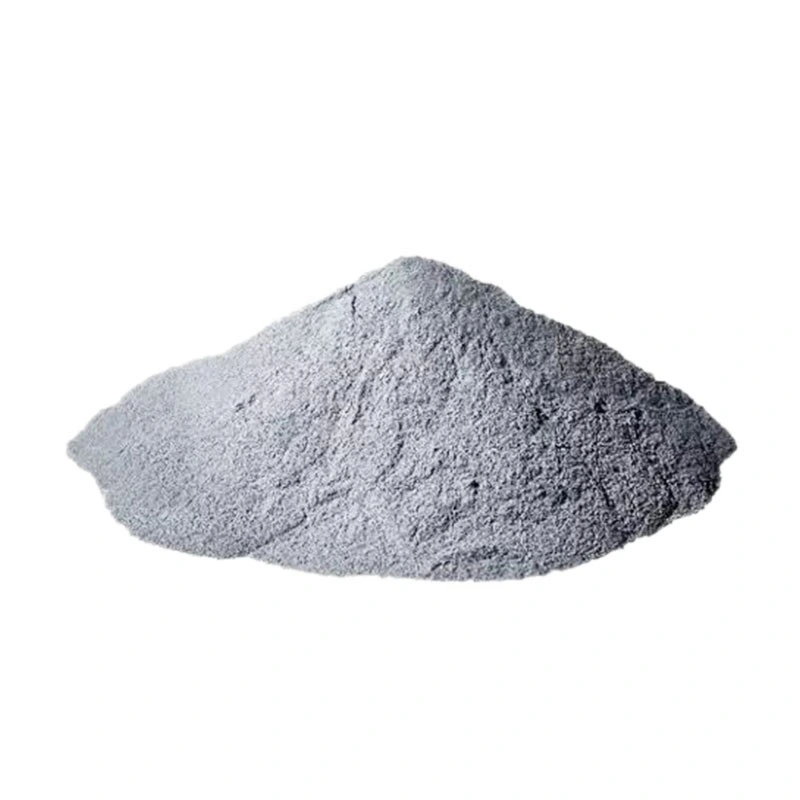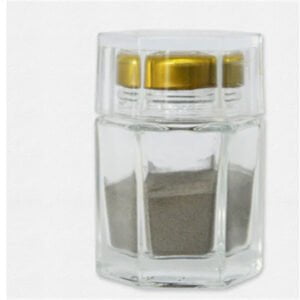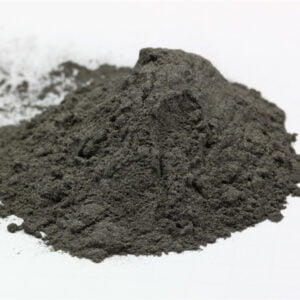Pulver för 3D-utskrift
Innehållsförteckning
3D-utskrift, även känd som additiv tillverkning (AM), använder specialpulver för att konstruera tredimensionella komponenter i successiva skiktningsmetoder. Den här guiden är en djupgående referens om pulver för 3D-utskrift - med information om typer, egenskaper, specifikationer, tillverkningsmetoder, viktiga leverantörer och priser, tillämpningar i olika branscher, jämförelser med alternativ, vanliga frågor och mycket mer.
Översikt över Pulver för 3D-utskrift
3D-utskriftspulver är råmaterial som möjliggör tillverkning av tillsatsdelar över plast-, metall- och keramiska plattformar. Nyckelegenskaper:
- Tillstånd: Ultrafina partikelpulver
- Storleksområde: Vanligtvis 10-150 mikron
- Morfologi: Oftast sfärisk partikelform
- Sammansättning: Polymer, metallegering, keramik, sandstensblandningar
- Nyckelegenskaper: Konstruerad partikelstorleksfördelning, flytbarhet, packdensitet och mikrostruktur
Genom att utnyttja strikt kontroll av pulvrets fysikaliska egenskaper och interaktioner med termiska/kinetiska utskriftsprocesser, underlättar 3D-utskriftspulver intrikata detaljgeometrier och materialsammansättningsgradienter som inte kan uppnås annars.

Olika typer av pulver för 3D-utskrift
| Kategori | Material | Tryckmetod |
|---|---|---|
| Plast | Nylon, ABS, TPU, PEKK, PEEK... | Selektiv lasersintring (SLS) |
| Metaller | Rostfritt, verktygsstål, titan och legeringar, superlegeringar... | Lasersintring av direktmetall (DMLS) |
| Keramik | Aluminiumoxid, zirkoniumoxid, kiselkarbid | Binder jetting, fused deposition modellering |
| Kompositer | Metall/plastblandningar, sandstensblandningar | Multi jet fusion (MJF), bunden metalldeposition |
| Biokompatibel | PEEK, PLGA, TCP... | Selektiv lasersmältning (SLM) |
Tabell 1: Huvudkategorier, material och tillhörande utskriftsplattformar för kommersiella 3D-utskriftspulver
Polymer-, metall-, keramik- och kompositpulver stöder produktion av slutanvändningsdelar på flyg-, bil-, medicin-, dental- och industrimarknader.
Tillverkningsmetoder
| Metod | Beskrivning | Material lämplighet | Fördelar | Nackdelar |
|---|---|---|---|---|
| Atomisering | Denna paraplyterm omfattar olika tekniker som bryter ner smält metall till fina partiklar. Den smälta metallen tvingas genom ett munstycke in i en högtrycksgas- eller vattenström, vilket snabbt stelnar dropparna till sfäriska partiklar. | Metaller (järn, aluminium, titanlegeringar) | – Hög produktionshastighet – Konsekvent partikelstorlek och form – Bra pulverflytbarhet | – Kräver hög energitillförsel – Potential för oxidbildning på partiklar – Begränsad till vissa material |
| Atomisering av gas | Den vanligaste atomiseringsmetoden, med en inert gas (vanligtvis kväve) för att bryta upp den smälta metallen. | Liknar Atomization, men generellt bättre ytkvalitet och strängare kontroll över partikelstorlek. | – Överlägsen pulverkvalitet jämfört med andra finfördelningsmetoder – Lämplig för reaktiva metaller | Liknar Atomization, men högre utrustningskostnad |
| Atomisering av vatten | Använder en högtrycksvattenstråle för att fragmentera den smälta metallen. Mer kostnadseffektiv än gasförstoftning men ger mindre sfäriska partiklar. | Vissa metaller (järn, koppar) och vissa polymerer | – Lägre kostnad än gasatomisering – Väl lämpad för fuktokänsliga material | – Lägre pulverkvalitet (oregelbundna former) – Kanske inte idealiskt för högpresterande applikationer |
| Plasmaatomisering | En elektrisk ljusbåge värmer råmaterialet (metalltråd eller pulver) till ett smält tillstånd. Den smälta metallen sprutas sedan ut genom ett munstycke och finfördelas med en plasmabrännare. | Brett utbud av material (metaller, legeringar, keramik) | – Klarar material med hög smältpunkt – Lämplig för att skapa kompositpulver | – Komplex och kostsam process – Kräver stränga säkerhetsåtgärder |
| Mekanisk Pulverisering | En fysisk process som maler eller maler bulkmaterial till fint pulver. | Spröda material (keramik, vissa polymerer) | – Enklare och billigare installation jämfört med andra metoder | – Begränsad kontroll över partikelstorlek och morfologi – Kan införa föroreningar under malning |
| Kemisk förångningsdeposition (CVD) | En kemisk process där gasformiga prekursorer reagerar för att bilda en fast avlagring på en fröpartikel. | Metaller, keramik och vissa avancerade material | – Hög renhet och exakt kontroll över partikelsammansättningen – Kan skapa komplexa geometrier | – Långsam process med begränsad produktionstakt – Hög kapitalinvestering |
| Elektrolytisk atomisering | En elektrolytisk cell används för att bryta ner en metallanod till joner. Jonerna kombineras sedan med elektroner vid katoden för att bilda metallpartiklar. | Metaller | – Miljövänlig process (undviker höga temperaturer) – Lämplig för fuktkänsliga material | – Lägre produktionshastighet än finfördelningsmetoder – Begränsad till vissa elektrolyter och anodmaterial |
| Sfäroidisering | En ytterligare process som används för att förbättra formen på oregelbundet formade pulver framställda med andra metoder. Innebär värmebehandling eller kemiska processer för att uppmuntra partikelagglomerering i sfärer. | De flesta pulvertyper (metaller, polymerer, keramik) | – Förbättrar pulverflytbarheten och packningsdensiteten – Förbättrar tryckbarheten | – Lägger till ett extra bearbetningssteg – Kanske inte nödvändigt för alla applikationer |
Egenskaper för Pulver för 3D-utskrift
| Fastighet | Beskrivning | Betydelse för 3D-utskrift | Exempel & överväganden |
|---|---|---|---|
| Partikelstorlek och distribution | Avser variationen i storlek hos enskilda pulverpartiklar och den totala spridningen över olika storleksintervall. Uppmätt i mikrometer (µm). | Spelar en avgörande roll för tryckbarhet, upplösning och slutlig deldensitet. – För stor: försvårad flytbarhet, ojämn spridning och risk för krattadefekter. – För liten: ökad yta kan leda till kakning och dålig packning, vilket påverkar styrkan. | – SLS (selektiv lasersintring): Föredrar i allmänhet finare pulver (20-80 µm) för detaljerade egenskaper. – MJF (Multi Jet Fusion): Något större partiklar (50-100 µm) kan användas på grund av bläckstråleteknikens förmåga att övervinna flödesbegränsningar. – Metallpulver: Tät fördelning (smalt område) är idealiskt för god packningstäthet och minimal porositet i den sista delen. |
| Partikelmorfologi | Formen på enskilda pulverpartiklar. | Påverkar hur väl partiklarna packar ihop, flytbarhet och ytfinish hos den sista delen. – Sfärisk: Erbjud den bästa packningsdensiteten och flytbarheten, vilket leder till starka och enhetliga delar. – Oregelbundna former: Kan skapa luckor och inkonsekvenser, vilket potentiellt påverkar styrka och ytkvalitet. | – Plastpulver: Generellt sfärisk eller nästan sfärisk för optimal tryckbarhet. – Metallpulver: Kan variera beroende på metall och tillverkningsmetod. Sfäriska morfologier föredras men kan uppnås genom efterbearbetningstekniker som finfördelning. |
| Flytbarhet | Den lätthet med vilken pulver flyter under sin egen vikt eller med minimal skjuvkraft. | Kritisk för konsekvent materialavsättning och jämn skiktbildning under tryckning. – God flytbarhet: Säkerställer jämn spridning och minimerar risken för lagerdefekter. – Dålig flytbarhet: Kan leda till ojämn deponering, inkonsekvenser och potentiella utskriftsproblem. | – Pulver med en snäv partikelstorleksfördelning tenderar att flyta bättre på grund av mindre partikelstorleksinterferens. – Tillsatser och ytbehandlingar kan användas för att förbättra flytbarheten genom att minska friktionen mellan partiklar. |
| Packningstäthet | Måttet på hur tätt pulverpartiklar kan packas ihop. Uttryckt i procent av den totala volymen som upptas av pulvret. | Påverkar den slutliga densiteten, styrkan och dimensionsnoggrannheten för den tryckta delen. – Hög packningsdensitet: Leder till tätare delar med förbättrade mekaniska egenskaper och dimensionell precision. – Låg packningsdensitet: Resulterar i delar med högre porositet, potentiellt svagare och mindre dimensionellt noggranna. | – Partikelns form spelar en betydande roll. Sfäriska partiklar packas mer effektivt än oregelbundna former. – Processer som Binder Jetting kan dra nytta av något lägre packningsdensiteter för att möjliggöra korrekt bindemedelsinfiltration. |
| Sintringsbarhet | Pulverpartiklarnas förmåga att smälta eller binda samman under 3D-utskriftsprocessen, vanligtvis genom värme eller laserenergi. | Viktigt för att uppnå starka och funktionella tryckta delar. – Bra sinterbarhet: Möjliggör stark bindning mellan partiklar, vilket leder till robusta och funktionella delar. – Dålig sinterbarhet: Kan resultera i svaga bindningar och potentiellt delfel under stress. | – Materialsammansättning: Metaller har generellt god sinterbarhet på grund av sin inneboende förmåga att bilda starka bindningar vid höga temperaturer. – Polymerpulver kräver ofta specifika tillsatser eller efterbearbetningssteg (t.ex. sintringsugnar) för att förbättra bindningen. |
| Kemisk sammansättning | Den elementära makeupen av pudermaterialet. | Bestämmer de slutliga egenskaperna för den tryckta delen, såsom styrka, värmebeständighet och biokompatibilitet. – Materialval är avgörande utifrån önskad applikation och funktionskrav. – Pulver kan blandas för att uppnå specifika egenskaper (t.ex. genom att kombinera metaller för förbättrat förhållande mellan styrka och vikt). | – Metallpulver kan sträcka sig från rena metaller som titan till komplexa legeringar med skräddarsydda egenskaper. – Polymerpulver kan inkludera nylon, polyamider och biokompatibla material för medicinska tillämpningar. |
| Termiska egenskaper | Pulvermaterialets beteende under varierande temperaturer, inklusive smältpunkt, värmeledningsförmåga och värmeutvidgningskoefficient. | Påverkansfaktorer som dimensionsstabilitet, skevhet och värmeförvrängning under utskrift och efterbearbetning. – Kontrollerad uppvärmning är viktigt för att undvika att överskrida materialets termiska gränser och orsaka deldefekter. – Matchande termiska egenskaper hos pulver och byggplattform minimerar vridning och säkerställer dimensionell noggrannhet. | – Metallpulver har ofta höga smältpunkter och kräver exakt temperaturkontroll under laserbaserade processer som SLM (Selective Laser Melting). – Polymerpulver kan mjukna eller smälta vid lägre temperaturer, |
Specifikationer för 3D-utskriftspulver
| Fastighet | Beskrivning | Inverkan på tryckbarhet och delkvalitet | Exempel på material |
|---|---|---|---|
| Partikelstorlek och distribution | Avser de individuella partikeldiametrarna och variationen inom pulvret. Mätt i mikron (µm). | Fina pulver (< 50 µm) erbjuder hög upplösning och ytfinish men kan vara utmanande att flyta och kan kräva speciell hantering. Grovare pulver (> 100 µm) förbättrar flytbarheten men kan begränsa detaljer och öka ytjämnheten. En snäv storleksfördelning säkerställer konsekvent packnings- och tryckbeteende. | Polymerer: Nylon (15-75 µm), polypropen (40-100 µm) |
| Partikelmorfologi | Formen på enskilda pulverpartiklar. | Sfäriska partiklar flyter fritt och packas effektivt, vilket leder till god tryckbarhet. Oregelbundna former kan förbättra bindningen mellan partiklar men kan orsaka flödesproblem och kräva specifika trycktekniker. | Polymerer: Typiskt sfärisk på grund av tillverkningsprocesser. |
| Skenbar densitet och packningsdensitet | Skenbar densitet är vikten av pulvret per volymenhet i sitt lösa, hällda tillstånd. Packningsdensiteten är den maximala densiteten som kan uppnås efter gängning eller vibration. | Skenbar densitet påverkar pulverflödet och hanteringen. Packningsdensiteten påverkar den tryckta delens slutliga densitet och dess mekaniska egenskaper. Högre packningsdensitet leder i allmänhet till starkare delar. | Polymerer: Skenbar densitet (0,3-0,8 g/cm³), packningsdensitet (0,5-0,9 g/cm³) |
| Flytbarhet | Den lätthet med vilken pulver flyter under gravitation eller med minimal omrörning. | God flytbarhet är avgörande för jämn pulverspridning under tryckning. Dålig flytförmåga kan leda till lagerinkonsekvenser och tryckfel. | Polymerer: Typiskt friflytande på grund av deras sfäriska morfologi. Tillsatser kan användas för att förbättra flytbarheten. |
| Fukthalt | Mängden vattenånga som fångas i pulverpartiklarna. | Överskott av fukt kan orsaka problem under utskrift, som ångexplosioner eller inkonsekvent smältbeteende. De flesta pulver kräver strikt fuktkontroll. | Polymerer: Vanligtvis mycket låg fukthalt (< 0,1 wt%) för att förhindra hydrolys och säkerställa konsekvent utskriftsbeteende. |
| Kemisk sammansättning & renhet | Pulvrets elementära makeup och närvaron av eventuella föroreningar. | Den kemiska sammansättningen avgör de slutliga egenskaperna hos den tryckta delen. Föroreningar kan påverka tryckbarhet, mekanisk prestanda och ytkvalitet. | Polymerer: Material av hög renhet används för att säkerställa konsekventa egenskaper och tryckbarhet. |
| Termiska egenskaper | Smältpunkt, glasövergångstemperatur (Tg) för polymerer och värmeledningsförmåga. | Termiska egenskaper påverkar tryckprocessparametrarna och den slutliga mikrostrukturen hos den tryckta delen. | Polymerer: Smältpunkt och Tg är avgörande för att ställa in utskriftsparametrar som lasereffekt eller bäddtemperatur. |
Leverantörer av pulver för 3D-utskrift
| Material | Viktiga tillämpningar | Representativa leverantörer | Överväganden |
|---|---|---|---|
| Polymerpulver | – Prototyper – Funktionella delar – Medicintekniska produkter – Konsumentvaror | * Polyamid (nylon): BASF, Evonik, Arkema * Polymjölksyra (PLA): NatureWorks, ExxonMobil Chemical, DuPont * Polypropen (PP): Royal DSM, SABIC, Repsol | * Partikelstorlek och distribution påverkar tryckbarheten och de slutliga delarnas egenskaper. * Materialegenskaper som värmebeständighet, flexibilitet och biokompatibilitet varierar. * Tänk på kemisk kompatibilitet med efterbearbetningstekniker. |
| Metallpulver | – Flygkomponenter – Fordonsdelar – Medicinska implantat – Verktyg och formar | * Titanlegeringar: AP Powder Company, Höganäs, GE Additive * Rostfritt stål: Carpenter Additive Manufacturing, SLM Solutions, EOS GmbH * Aluminiumlegeringar: Rio Tinto Alcan, DLP Manufacturing, Exone | * Pulvermorfologi (form) påverkar flytbarhet och packningsdensitet. * Kornstorlek påverkar den sista delens mekaniska egenskaper. * Säkerhetsprotokoll är avgörande vid hantering av reaktiva metallpulver. |
| Kompositpulver | – Lätta strukturer med hög hållfasthet – Ledande komponenter – Biokompatibla implantat med förbättrade egenskaper | * Polymer-metallkompositer: LPW Technology, Markforged, Desktop Metal * Keramisk-metallkompositer: Sandvik Hyperion, Extrude Hone, Plasma Technik * Polymer-kolfiberkompositer: Stratasys, Desktop Metal, Henkel | * Urvalet beror på den önskade kombinationen av egenskaper (styrka, konduktivitet, biokompatibilitet). * Gränssnitt mellan olika material kräver noggrant övervägande för optimal prestanda. * Utskriftsparametrar kan behöva justeras jämfört med pulver av ett enda material. |
Tillämpningar av Pulver för 3D-utskrift
Tryckpulver underlättar på ett unikt sätt komplexa, skräddarsydda detaljgeometrier inom olika branscher:
| Industri | Exempel på komponenter | Fördelar |
|---|---|---|
| Flyg- och rymdindustrin | Turbinblad, raketmunstycken, UAV-chassi | Viktminskning, prestandaökningar |
| Medicinsk | Patientanpassade implantat, proteser | Personlig storlek, biokompatibilitet |
| Fordon | Värmeväxlare, lätta chassielement | Delar konsolidering, effektivitet |
| Industriell | Anpassade produktionsverktyg, jiggar | Förkortade utvecklingstidslinjer |
Tabell 5: Sektorer för stora användningsområden som drar fördel av 3D-utskriftspulverfunktioner
Möjligheten att snabbt upprepa design och skriva ut korta upplagor på ett ekonomiskt sätt möjliggör innovation för slutanvändning.

För- och nackdelar med pulverbaserad 3D-utskrift
| Proffs | Nackdelar |
|---|---|
| Hög noggrannhet och upplösning | Pulverhantering och säkerhet |
| Brett utbud av material | Begränsad byggstorlek |
| Minimala stödstrukturer | Krav på efterbearbetning |
| Snabba produktionspriser | Hög initial investering |
Vanliga frågor
F: Vilket partikelstorleksområde fungerar bäst för pulver för 3D-utskrift av metall?
S: 10-45 mikron underlättar bra packning och spridning samtidigt som man undviker utmaningar med ultrafina pulver kring pulverhantering. De flesta legeringar fungerar bra 30±15μm distribution.
F: Vilken polymerpulver 3D-utskriftsprocess ger den bästa mekaniska prestandan?
S: Selektiv lasersintring (SLS) möjliggör utmärkt sammansmältning och produktion av fina detaljer – skapar högpresterande plastdelar som konkurrerar med eller överträffar formsprutningsprocesser.
F: Hur länge kan oanvänt 3D-printpulver hålla i lagring?
S: Förvaras förseglad med torkmedel från fukt i en sval, torr miljö – pulver bibehåller flytegenskaper i minst 12 månader. Även öppnade puder håller i 6+ månader innan märkbar nedbrytning.
F: Påverkar kvaliteten på startpulvret avsevärt tryckta delars egenskaper?
A: Ja, pulverkemisk renhet plus adekvat kontroll av pulvrets egenskaper bestämmer starkt slutdelens mekaniska egenskaper, estetik, dimensionsnoggrannhet och prestandatillförlitlighet.
Dela på
MET3DP Technology Co, LTD är en ledande leverantör av lösningar för additiv tillverkning med huvudkontor i Qingdao, Kina. Vårt företag är specialiserat på 3D-utskriftsutrustning och högpresterande metallpulver för industriella tillämpningar.
Förfrågan för att få bästa pris och anpassad lösning för ditt företag!
Relaterade artiklar

Högpresterande segment för munstycksvingar: Revolutionerande turbineffektivitet med 3D-utskrift i metall
Läs mer "Om Met3DP
Senaste uppdateringen
Vår produkt
KONTAKTA OSS
Har du några frågor? Skicka oss meddelande nu! Vi kommer att betjäna din begäran med ett helt team efter att ha fått ditt meddelande.

Metallpulver för 3D-printing och additiv tillverkning
FÖRETAG
PRODUKT
cONTACT INFO
- Qingdao City, Shandong, Kina
- [email protected]
- [email protected]
- +86 19116340731















